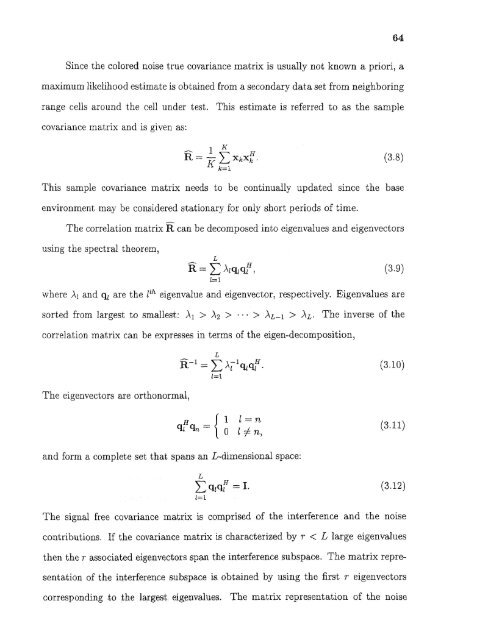Space/time/frequency methods in adaptive radar - New Jersey ...
Space/time/frequency methods in adaptive radar - New Jersey ...
Space/time/frequency methods in adaptive radar - New Jersey ...
You also want an ePaper? Increase the reach of your titles
YUMPU automatically turns print PDFs into web optimized ePapers that Google loves.
64S<strong>in</strong>ce the colored noise true covariance matrix is usually not known a priori, amaximum likelihood estimate is obta<strong>in</strong>ed from a secondary data set from neighbor<strong>in</strong>grange cells around the cell under test. This estimate is referred to as the samplecovariance matrix and is given as:This sample covariance matrix needs to be cont<strong>in</strong>ually updated s<strong>in</strong>ce the baseenvironment may be considered stationary for only short periods of <strong>time</strong>.The correlation matrix R can be decomposed <strong>in</strong>to eigenvalues and eigenvectorsus<strong>in</strong>g the spectral theorem,where A l and q 1 are the lth eigenvalue and eigenvector, respectively. Eigenvalues aresorted from largest to smallest: A i > A2 > • > AL-1 > AL. The <strong>in</strong>verse of thecorrelation matrix can be expresses <strong>in</strong> terms of the eigen-decomposition,The eigenvectors are orthonormal,and form a complete set that spans an L-dimensional space:The signal free covariance matrix is comprised of the <strong>in</strong>terference and the noisecontributions. If the covariance matrix is characterized by r < L large eigenvaluesthen the r associated eigenvectors span the <strong>in</strong>terference subspace. The matrix representationof the <strong>in</strong>terference subspace is obta<strong>in</strong>ed by us<strong>in</strong>g the first r eigenvectorscorrespond<strong>in</strong>g to the largest . eigenvalues. The matrix representation of the noise
















